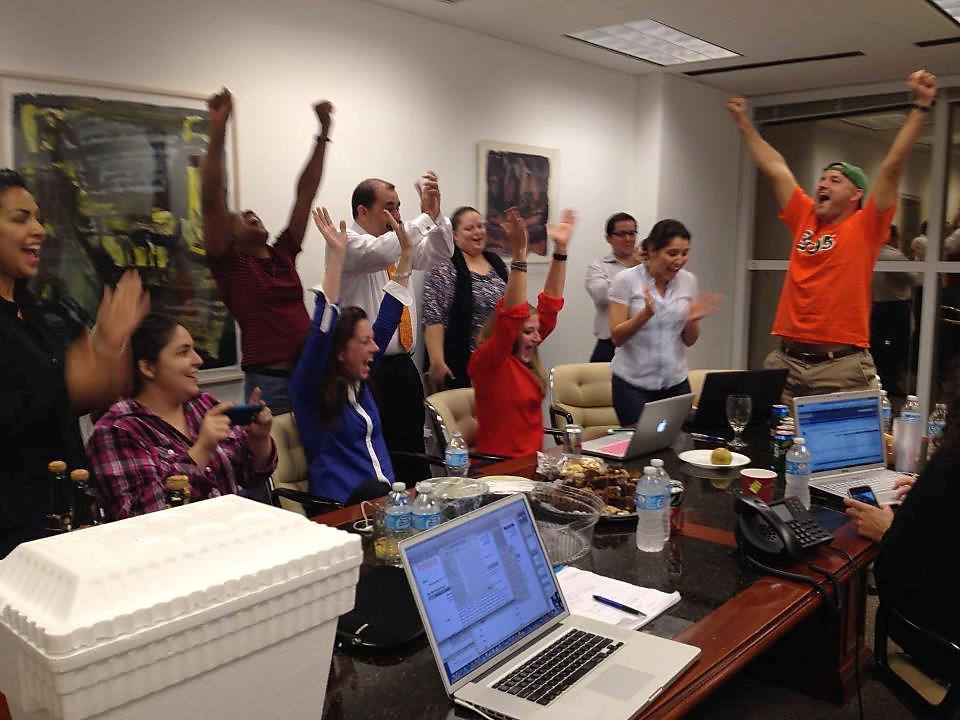
Beyond the dollars: How online Giving Days can support community foundations’ missions

The Miami Foundation celebrates reaching a goal on Give Miami Day in 2012. Photo courtesy The Miami Foundation.
Since 2013, Knight Foundation has helped community foundations experiment with online fundraising campaigns known as Giving Days. To date these Giving Days have raised $81.2 million dollars in 17 communities for 12,924 nonprofits. Beyond the dollars, our research has shown that these Giving Days provide community foundations with increased visibility in their community, engagement with new donors and better relationships with the nonprofit community.
Despite these benefits, Giving Day organizers still struggle with the amount of time these campaigns take and the cost of running them. For these Giving Days to support both nonprofits and community foundations in the long term, organizers are starting to focus on reducing costs and aligning Giving Days with their overall structure and mission.
Our evaluation partner, Third Plateau Social Impact Strategies, has found that community foundations participating in Knight’s Giving Day Initiative are making their campaigns sustainable by employing some of the following tactics:
1. No longer covering fees
Some community foundations are not covering online donation fees for nonprofit participants. Instead, they are transitioning the fees to nonprofits and donors by deducting the charges from their total earnings, or adding an option for donors to cover the fees associated with their donations upon checkout.
The Community Foundation of Sarasota County strongly believes that covering donation-processing fees perpetuates the myth that fundraising is free. When communicating the donation-processing fee for their Giving Challenge, foundation staff reiterates the cost of bringing in new donors for nonprofits and the reality that the foundation operates the campaign at a loss while providing hundreds of thousands of dollars in matching funds and significant staff time.
2. Building community partnerships
As Giving Days grow in popularity, organizers are looking to create community partnerships both to offset costs and staff time and to provide access to a larger network of potential donors. Community foundations are finding partners in other community foundations, United Way chapters, corporations, professional groups and, increasingly, the nonprofit participants themselves.
Many community foundations are shifting pre-Giving Day fundraising to nonprofit participants by training and encouraging them to raise their own matching funds and secure donors in advance. For example, Minnesota’s Give to the Max Day no longer offers a campaign-wide match, and trains and relies on nonprofits to raise their own matching funds.
3. Cultivating donor-advised fund holders
Community foundations primarily benefit from attracting and retaining donor-advised funds. Managing these funds is not only a revenue stream for community foundations, but also helps build long-lasting relationship between the community foundation, donors and nonprofits.
Though most community foundations are still in the beginning phase of developing strategies around attracting new donor-advised funds to their foundations through their Giving Days, they have found that communicating with current fundholders directly with a personalized note or phone call has been successful in encouraging participation. Blue Grass Community Foundation in Lexington, Ky., used a personalized letter to request that fundholders donate to their match pools, and the Community Foundation of Sarasota County communicated with fundholders a month in advance with a Giving Day donation form and reminder of their exemption from processing fees.
4. Growing existing endowment funds and opening new ones
Community foundations have a vested interest in helping nonprofits build endowment funds, as they are a critical component of an organization’s long-term financial security and provide a source of revenue for community foundations. For example, Legacy Foundation in Merrillville, Ind., is experimenting with a nine-month training program focused on building endowment funds for six nonprofits in their area, and Blue Grass Community Foundation has restricted eligibility for their Giving Day incentive funds to organizations with endowments at the community foundation.
5. Learning from each other
Throughout Knight’s Giving Day Initiative, community foundations have participated in an online peer learning group on Facebook to share insights, ask questions and learn from each other about how each foundation is approaching these questions of sustainability. Additionally, case studies, best practices and tools are compiled into the Giving Day Playbook, which provides the field of philanthropy with a crowdsourced database of Giving Day materials.
The road ahead…
As community foundations take a leading role in organizing Giving Days, they are increasingly finding ways to make them cost-effective and aligned with their overall mission. However, there is still more to learn before Giving Days can move from projects that are supported by community foundations to projects that support community foundations’ long-term success. Over the next year, Knight Foundation will continue to learn from these community foundations as they experiment with sustainable practices.
We’ll also to be hosting a free series of webinars to provide insights for community foundations interested in launching a Giving Day and advanced topics for experienced Giving Day organizers on branding, corporate sponsorships and reaching diverse donors. You can learn more about that series, running from August to October 2015, and register at givingdayplaybook.org/webinar.
Anna Dilernia is a member of the Learning and Impact team at Knight Foundation. Email her at [email protected] or follow her on Twitter @AnnaDilernia.
Recent Content
-
Community Impactarticle ·
-
Community Impactarticle ·
-
Community Impactarticle ·



